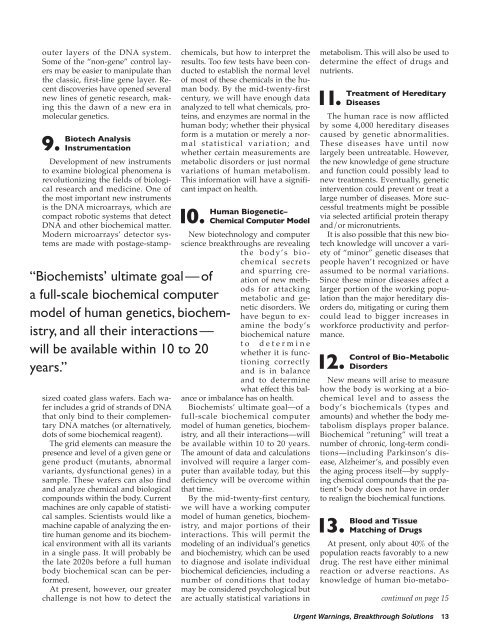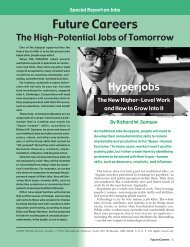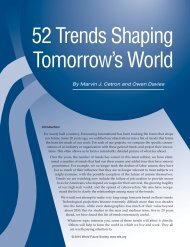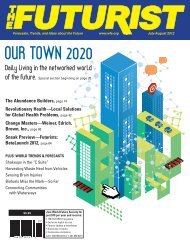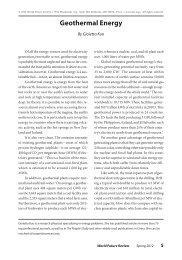Urgent Warnings, Breakthrough Solutions, Second Edition
Urgent Warnings, Breakthrough Solutions, Second Edition
Urgent Warnings, Breakthrough Solutions, Second Edition
Create successful ePaper yourself
Turn your PDF publications into a flip-book with our unique Google optimized e-Paper software.
outer layers of the DNA system.<br />
Some of the “non-gene” control layers<br />
may be easier to manipulate than<br />
the classic, first-line gene layer. Recent<br />
discoveries have opened several<br />
new lines of genetic research, making<br />
this the dawn of a new era in<br />
molecular genetics.<br />
9.<br />
Biotech Analysis<br />
Instrumentation<br />
At present, only about 40% of the<br />
population reacts favorably to a new<br />
drug. The rest have either minimal<br />
reaction or adverse reactions. As<br />
knowledge of human bio-metabochemicals,<br />
but how to interpret the<br />
results. Too few tests have been conducted<br />
to establish the normal level<br />
of most of these chemicals in the human<br />
body. By the mid-twenty-first<br />
century, we will have enough data<br />
analyzed to tell what chemicals, proteins,<br />
and enzymes are normal in the<br />
human body; whether their physical<br />
form is a mutation or merely a normal<br />
statistical variation; and<br />
whether certain measurements are<br />
metabolic disorders or just normal<br />
variations of human metabolism.<br />
This information will have a significant<br />
impact on health.<br />
10.<br />
“Biochemists’ ultimate goal — of<br />
a full-scale biochemical computer<br />
model of human genetics, biochemistry,<br />
and all their interactions —<br />
will be available within 10 to 20<br />
years.”<br />
Development of new instruments<br />
to examine biological phenomena is<br />
revolutionizing the fields of biological<br />
research and medicine. One of<br />
the most important new instruments<br />
is the DNA microarrays, which are<br />
compact robotic systems that detect<br />
DNA and other biochemical matter.<br />
Modern microarrays’ detector systems<br />
are made with postage-stampsized<br />
coated glass wafers. Each wafer<br />
includes a grid of strands of DNA<br />
that only bind to their complementary<br />
DNA matches (or alternatively,<br />
dots of some biochemical reagent).<br />
The grid elements can measure the<br />
presence and level of a given gene or<br />
gene product (mutants, abnormal<br />
variants, dysfunctional genes) in a<br />
sample. These wafers can also find<br />
and analyze chemical and biological<br />
compounds within the body. Current<br />
machines are only capable of statistical<br />
samples. Scientists would like a<br />
machine capable of analyzing the entire<br />
human genome and its biochemical<br />
environment with all its variants<br />
in a single pass. It will probably be<br />
the late 2020s before a full human<br />
body biochemical scan can be performed.<br />
At present, however, our greater<br />
challenge is not how to detect the<br />
Human Biogenetic–<br />
Chemical Computer Model<br />
New biotechnology and computer<br />
science breakthroughs are revealing<br />
the body’s biochemical<br />
secrets<br />
and spurring creation<br />
of new methods<br />
for attacking<br />
metabolic and genetic<br />
disorders. We<br />
have begun to examine<br />
the body’s<br />
biochemical nature<br />
t o d e t e r m i n e<br />
whether it is functioning<br />
correctly<br />
and is in balance<br />
and to determine<br />
what effect this balance<br />
or imbalance has on health.<br />
Biochemists’ ultimate goal—of a<br />
full-scale biochemical computer<br />
model of human genetics, biochemistry,<br />
and all their interactions—will<br />
be available within 10 to 20 years.<br />
The amount of data and calculations<br />
involved will require a larger computer<br />
than available today, but this<br />
deficiency will be overcome within<br />
that time.<br />
By the mid-twenty-first century,<br />
we will have a working computer<br />
model of human genetics, biochemistry,<br />
and major portions of their<br />
interactions. This will permit the<br />
modeling of an individual’s genetics<br />
and biochemistry, which can be used<br />
to diagnose and isolate individual<br />
biochemical deficiencies, including a<br />
number of conditions that today<br />
may be considered psychological but<br />
are actually statistical variations in<br />
metabolism. This will also be used to<br />
determine the effect of drugs and<br />
nutrients.<br />
11.<br />
Treatment of Hereditary<br />
Diseases<br />
The human race is now afflicted<br />
by some 4,000 hereditary diseases<br />
caused by genetic abnormalities.<br />
These diseases have until now<br />
largely been untreatable. However,<br />
the new knowledge of gene structure<br />
and function could possibly lead to<br />
new treatments. Eventually, genetic<br />
intervention could prevent or treat a<br />
large number of diseases. More successful<br />
treatments might be possible<br />
via selected artificial protein therapy<br />
and/or micronutrients.<br />
It is also possible that this new biotech<br />
knowledge will uncover a variety<br />
of “minor” genetic diseases that<br />
people haven’t recognized or have<br />
assumed to be normal variations.<br />
Since these minor diseases affect a<br />
larger portion of the working population<br />
than the major hereditary disorders<br />
do, mitigating or curing them<br />
could lead to bigger increases in<br />
workforce productivity and performance.<br />
12.<br />
Control of Bio-Metabolic<br />
Disorders<br />
New means will arise to measure<br />
how the body is working at a biochemical<br />
level and to assess the<br />
body’s biochemicals (types and<br />
amounts) and whether the body metabolism<br />
displays proper balance.<br />
Biochemical “retuning” will treat a<br />
number of chronic, long-term conditions—including<br />
Parkinson’s disease,<br />
Alzheimer’s, and possibly even<br />
the aging process itself—by supplying<br />
chemical compounds that the patient’s<br />
body does not have in order<br />
to realign the biochemical functions.<br />
13.<br />
Blood and Tissue<br />
Matching of Drugs<br />
continued on page 15<br />
<strong>Urgent</strong> <strong>Warnings</strong>, <strong>Breakthrough</strong> <strong>Solutions</strong> 13


